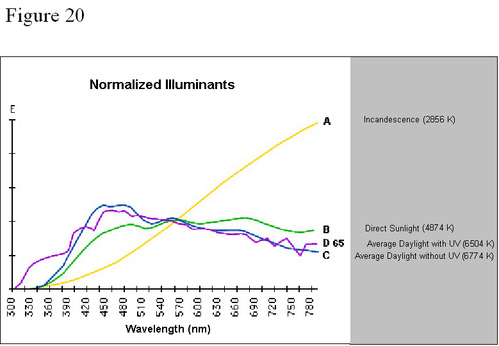
Introduction
The color of a non-self-emitting object is meaningful only if some light coming from a light source is sent onto the object, which will scatter, reflect or transmit the light towards the eye of the observer. This means that defining the color of an object means specifying the illuminant as well: it is then of utmost importance to be able to specify precisely which illuminant is used when attempting to quantify the color of an object.
The simplest illuminant would certainly be the equienergetic white source (see § C.2.e. “Equienergetic stimulus”) since its spectral distribution is constant throughout the whole visible spectrum. However, such an ideal source does not exist in practice. In cases where an object is illuminated by artificial incandescent light, the CIE recommends using the illuminant A which corresponds to a blackbody with a color temperature of 2856 K. This illuminant is realized with an incandescent tungsten light bulb. The illuminant C, close to daylight, can be realized by combining the illuminant A with a liquid filter, in order to achieve a correlated color temperature of 6774K. The normalized illuminants D50, D55, D65, D75 represent different phases of daylight, corresponding to correlated color temperatures of 5004, 5504, 6504 and 7504K, respectively. The spectral composition of the main normalized illuminants is shown in figure 20.

For illuminants, or more generally for any self-emitting object, it is useful to introduce the relative energetic spectral distribution
 in such a way that the trichromatic coordinates
in such a way that the trichromatic coordinates
 ,
,
 and
and
 of the illuminant are:
of the illuminant are:
or if
 is tabulated with a sampling pitch
is tabulated with a sampling pitch
 :
:
The scaling factor
 is then defined by:
is then defined by:
so that the
 component of the reference illuminant is equal to 100. Under these conditions, thes
component of the reference illuminant is equal to 100. Under these conditions, thes
 and
and
 components are the ones that are reported in table 2. If
components are the ones that are reported in table 2. If
 is to be equal to the visual luminance
is to be equal to the visual luminance
 and if
and if
 then
then
 must be equal to
must be equal to
 .
.